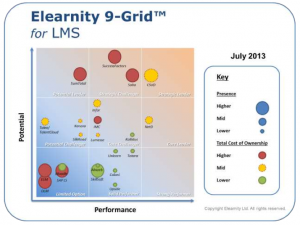Technology analyst Elearnity has published research insights into learning management systems and bespoke e-learning development in the UK and EMEA.
The research uses the analyst’s newly-developed 9-Grid model and is based on independent analysis and insights from the organisation’s corporate research network of over 150 organisations including BP, Lloyds Banking Group, Rolls Royce and Vodafone.
Elearnity says the aim of both models is to demonstrate the relative value of the solutions available in the market based on five levels of insight:
- Performance – comprising of two elements: market performance and customer performance.
- Potential – scope, capability and sophistication.
- Presence – historic and current presence in the market. This includes the size of the customer base, the number of enterprise customers and the overall size of the business, within the scope of the market segment
we are examining. - Total cost of ownership – the FULL cost of acquiring, implementing and operating the solution (typically over a 3 year period). Importantly, this includes both internal and external costs.
- Future trajectory – Elearnity’s view of their direction of travel in terms of performance and potential, relative to their current position and the market as a whole.
 In its 9-Grid analysis of LMS providers, Elearnity rates Sum Total as a ‘potential leader’, SuccessFactors and Saba as a ‘strategic challenger’ and Cornerstone on Demand as a ‘strategic leader’. Following behind are the ‘potential challengers’ Taleo, Kenexa and Silk Road.
In its 9-Grid analysis of LMS providers, Elearnity rates Sum Total as a ‘potential leader’, SuccessFactors and Saba as a ‘strategic challenger’ and Cornerstone on Demand as a ‘strategic leader’. Following behind are the ‘potential challengers’ Taleo, Kenexa and Silk Road.
E-learnity says The 9-Grid approach has been created in response to what it sees as a lack of depth and flexibility provided by existing analyst models. It hopes the 9-Grid model will help buyers trying to decide which LMS and e-learning solutions best meet their needs.
Elearnity managing director, David Wilson, said: ‘Fitting the right vendor with your specific needs is a vital ingredient for success, but up until now, there has been very little independent analysis that accurately reflects the market, especially for UK and EMEA organisations. Most other analyst models are US-centric and therefore can be of limited real value to organisations in Europe seeking to make the best decision about which learning and talent technologies to invest in.’
The two 9-Grid models released today are the first in a series from Elearnity focusing on the main segments of the learning and talent market. Elearnity will be releasing further 9-Grid™ models later in 2013, including for Integrated Talent Management and for E-Learning Authoring Platforms, with others to follow.
- To read the 9-Grid analysis of Learning management Systems, click here.
- To read the 9-Grid analysis of Bespoke E-learning Development, click here.



